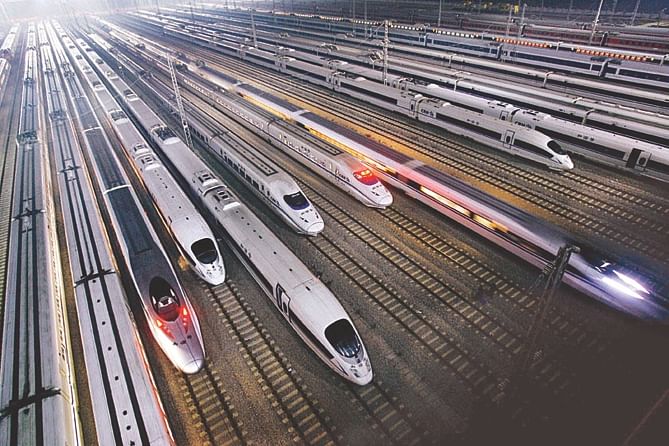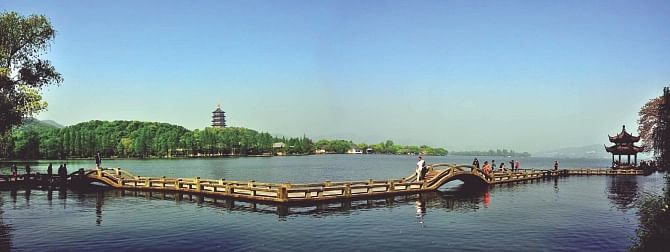'Economic Belt along the Silk Road' and 'Maritime Silk Road of the 21 century': Great opportunity for Bangladesh

IN his separate visits to Kazakhstan and Indonesia in September and October 2013, H.E. Mr. Xi Jinping, Hon'ble President of the People's Republic of China, called for joint development of an "Economic Belt along the Silk Road" and a "Maritime Silk Road of the 21st Century"(“One Belt and One Road”). These are two major initiatives that China has made to deepen reform and opening-up and advance its neighborhood diplomacy, which have been enthusiastically received both at home and abroad.
1. 'One Belt and One Road' initiatives feature "five links" and focuses on result-oriented and project-based cooperation, all aimed at bringing tangible benefits to the people in the region.
The first of the "five links" is policy. Countries can discuss strategies and policies on economic development and in the spirit of seeking common ground while shelving differences, harmonizing their positions through consultation, formulate corresponding plans and measures for cooperation and give regional economic integration their policy and legal "green light".
The second "link" is road. We have a saying in China that goes "if you want to get rich, get started by building roads." Many countries share this view. There is need for China and its neighboring countries to improve on their cross-border transportation infrastructure, put in place a transportation network linking Asia's sub-regions and connecting Asia with Europe and Africa and effectively address the existing inadequacies of connectivity and transportation in regions targeted by the project.
The third "link" is trade. We should study issues of trade and investment facilitation while making proper arrangements accordingly, remove trade and investment barriers, promote economic circulation and improvement in the region, unleash still greater trade and investment potential of participating countries and make the regional cooperation "pie" still bigger.

The fourth "link" is currency. We should promote greater trade settlement in local currencies and more currency swap schemes, strengthen bilateral and multilateral financial cooperation, set up financial arms for regional development, bring down transaction costs, enhance capacity to fend off financial risks through regional arrangement and make the region's economy more competitive globally.
The fifth "link" is people. Amity between peoples holds the key to sound relations between states. China and the neighboring countries need to shore up popular support for their state-to-state relations, promote inter-civilization dialogue, and enhance exchanges, understanding and friendship among different peoples, especially those at the grassroots level.
2. The basic principles of “One Belt and One Road” initiatives are as follows:
A. Continuation of the spirit of the ancient Silk Road. Facing a complex international and regional landscape, the Silk Road has become all the more important and precious as a symbol of peace, cooperation, openness, inclusiveness, mutual learning and resilience. It is all the more crucial for the international community to embrace the spirit of the ancient Silk Road, bring it to date, instill greater dynamism, and realize its value in this new age, thus creating a new material and cultural wealth for humanity.
B. Deepening regional integration. “One Belt and One Road” initiatives foresee infrastructure development and systemic innovation, which conduces to an improved business environment in relevant countries and the region as a whole, to an orderly and unimpeded flow of production factors and their improved distribution, to the development of landlocked countries and the remote areas of various countries, to lowering costs and trade and investment barriers, and to providing greater drive for reform and opening-up in the various countries.
C. Promoting global stability. China hopes to participate more actively in international affairs including those in the neighborhood through “One Belt and One Road”initiatives, highlighting the concept of amity, sincerity, mutual benefit and inclusiveness, providing more public goods and playing a more effective role as a responsible major country. The initiatives will also help dovetail China, its neighbors and other Eurasian countries on the issue of development strategies, build an even closer network of common interests, bring integration of respective interests to a higher level, and therefore contribute to global stability.
D. Advocating open and inclusive economic cooperation. 'One Belt and One Road' initiatives look at ideas and suggestions for cooperation and development. They are not about building an entity or creating new mechanisms. The initiatives will be built on the continuation and upgrading of existing bilateral and multilateral mechanisms, such as the Shanghai Cooperation Organization, the Eurasian Economic Community and ASEAN Plus China. The parties involved may consider linking their cooperation projects, both existing and planned, together into an integrated package for multiplied cost-effectiveness.
E. Pursuing common prosperity. All the projects and modalities of “One Belt and One Road” initiatives are designed to achieve mutual benefit and common development in the region. China will follow the right approach of upholding justice first and pursuing justice and interests simultaneously, provide developing countries and friendly neighbors with assistance as its abilities permit, and earnestly help them to achieve speedier growth. China will step up its input in the neighborhood, actively enhance connectivity there, explore the establishment of a regional infrastructure investment and financing platform, and strive to turn the neighboring land and sea area into those of peace, and prosperity.
3. 'One Belt and One Road' initiatives will bring great opportunity for Bangladesh.
Bangladesh is sandwiched by South Asia, East Asian and Southeast Asia and locates at the north of Bay of Bengal. In ancient times, Bangladesh was one of the most important destinations of Southern Silk Road and Maritime Silk Road. Nowadays Bangladesh could be the one of the link points of “One Belt and One Road”. And the implementation of the initiatives will help Bangladesh to transform its geographical advantage into economic benefits:
* Regional connectivity network will help Bangladesh to emerge as the transportation hub in the Asia-Pacific region.
* Energy cooperation will ease Bangladesh from energy and power insufficiency.
* Establishment of industrial zones in Bangladesh will attract huge investment and could contribute to more balanced trade for Bangladesh.
* Free trade facilitation will help Bangladesh get access to huge market in China, India and elsewhere.
* Furthermore, it is estimated that in the next five years, China will invest an additional $500 billion in other countries, import over $10 trillion of products and send 400 million tourists abroad. Bangladesh, as China's close neighbor and trusted friend, shall take an even more favorable posture to make good use of “Chinese opportunities”.
4. BCIM Economic Corridor is on the top agenda of “One Belt and One Road”initiatives.
China, Bangladesh, India and Myanmar are connected by the Southern Silk Road and Maritime Silk Road since ancient times. The proposed BCIM Economic Corridor is located in the intersection of the “Belt” and “Road” and will be the priority direction to materialize the “Belt” and “Road” initiatives.
Since 2013, the initiative of Bangladesh-China-India-Myanmar Economic Corridor (BCIM-EC) has maintained good momentum of development with collaboration of the BCIM countries. The first inter-governmental Joint Group Meeting took place in Yunnan of China in December 2013. The BCIM countries are expected to present their country reports in the forthcoming second Joint Group Meeting, which is scheduled to be held in Bangladesh in October 2014. China and India are two largest emerging economies and Bangladesh and Myanmar boasts rich natural and human resources, this economic corridor could enable the four countries to work with each other's advantages, accelerate economic growth, and open wider to the outside world. We can dream of a world where one can have breakfast in Kunming, lunch in Dhaka, and dinner in Kolkata.

 For all latest news, follow The Daily Star's Google News channel.
For all latest news, follow The Daily Star's Google News channel. 



Comments